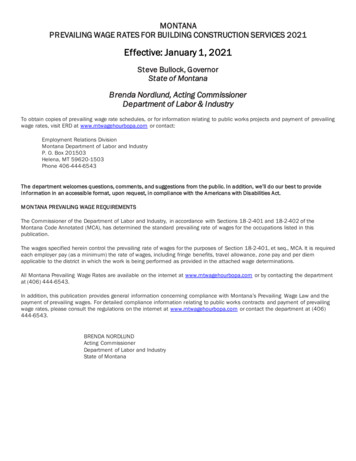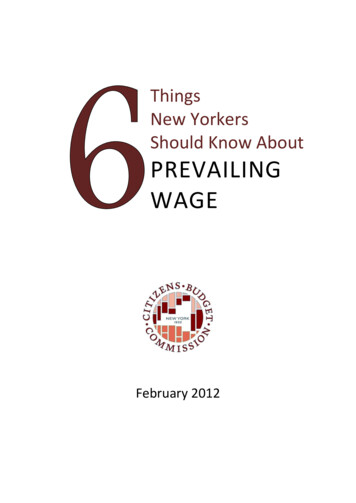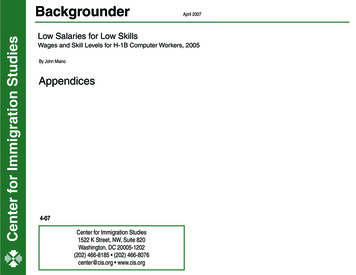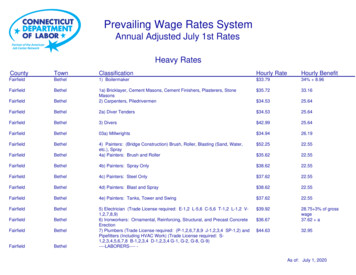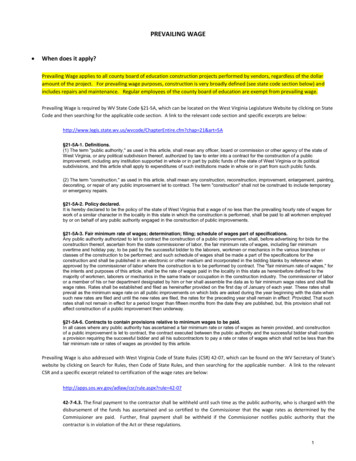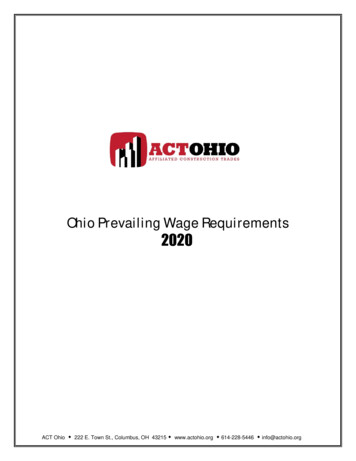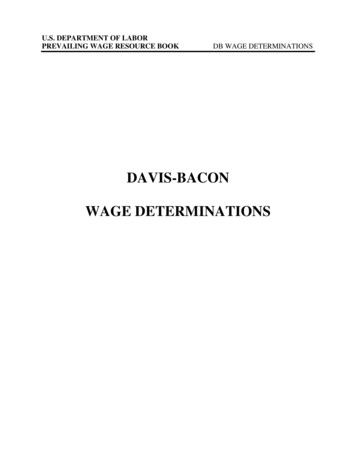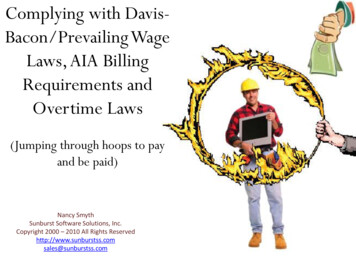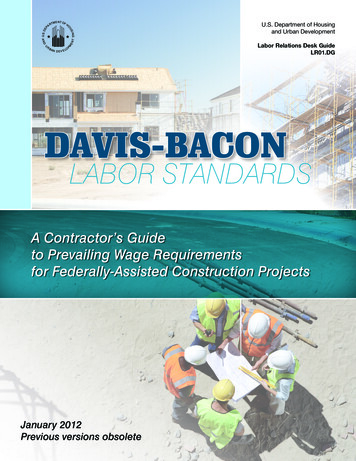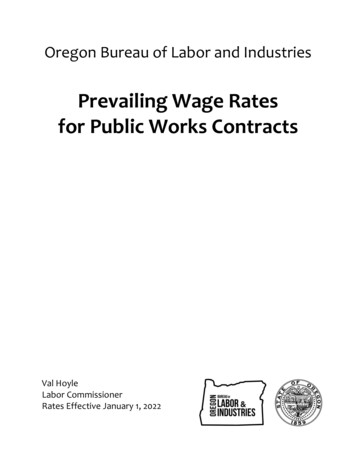
Transcription
Oregon Bureau of Labor and IndustriesPrevailing Wage Ratesfor Public Works ContractsVal HoyleLabor CommissionerRates Effective January 1, 2022
In this rate book are the new prevailing wage rates for Oregon non-residential public worksprojects, effective January 1, 2022.Prevailing wage rates are the minimum hourly wages that must be paid to all workers employed onall public works projects. In the 2021 Legislative Session, the Legislature passed Senate Bill (SB)493 which was signed by the Governor with the effective date of January 1, 2022. SB 493 amendsstate PWR law (ORS 279C.815) and provides that the prevailing rate of wage for each locality isthe wage in the collective bargaining agreement that covers that occupation. If more than onecollective bargaining agreement covers that occupation, the highest rate of wage among thecollective bargaining agreements will prevail. Accordingly, the rates in this book are determinedusing wage information from current collective bargaining agreements for each trade andoccupation for each of the 14 geographic regions of the state.Thank you for your engagement in the process and commitment to Oregon law.Our team is ready to help support you with any questions you have. We also offer regular, freeinformational seminars and webinars for contractors and public agencies. Contact us atPWR.Email@boli.oregon.gov or (971) 353-2416.Val HoyleLabor CommissionerMore information about prevailing wage rates:The Oregon Bureau of Labor & Industries publishes the prevailing wage rates (PWR) that arerequired to be paid to workers on non-residential Oregon public works projects.A separate document, Definitions of Covered Occupations for Public Works Contracts in Oregon,provides occupational definitions used to classify the duties performed on public works projects.These definitions are used to find the correct prevailing wage rate.The rate book and definition publications are available online at https://www.oregon.gov/boli aswell as additional information and supporting documents and forms.Please contact us at PWR.Email@boli.oregon.gov or (971) 353-2416, for additional informationsuch as: Applicable prevailing wage rates for projects (Generally, the rates in effect at the time the bidspecifications are first advertised are those that apply for the duration of the project.) Federal Davis-Bacon rates (In cases where projects are subject to both state PWR and federalDavis-Bacon rates, the higher wage must be paid.) Required PWR provisions for specifications and contracts Apprentice rates
TABLE OF CONTENTSJANUARY 1, 2022Required Postings for Contractors and Subcontractors1Public Works Bonds2Finding the Correct Prevailing Wage Rate3Prevailing Wage Rates by Occupations5List of Ineligible Contractors27Forms necessary to comply with ORS 279C.800 through ORS 279C.870 can be found s/Pages/prevailing-wage.aspx.Contractors are encouraged to use and keep on file the forms provided as master copies foruse on future prevailing wage rate projects.All of the information in this booklet can be accessed and printed from the Internetat: www.oregon.gov/BOLIPursuant to ORS 279C.800 to ORS 279C.870, the prevailing wage rates contained in thisbooklet have been adopted for use on public works contracts in Oregon.
Required Postings for Prevailing WageContractors and SubcontractorsPREVAILING WAGE RATESEvery contractor and subcontractor engaged in work on a public works must post theapplicable prevailing wage rates for that project in an obvious place on the worksite soworkers have ready access to the information.DETAILS OF FRINGE BENEFIT PROGRAMSWhen a contractor or subcontractor provides or contributes to a health and welfare planor a pension plan, or both, for employees who are working on a public works project, thedetails of all fringe benefit plans or programs must be posted on the worksite.The posting must include a description of the plan or plans, information about how andwhere claims can be made and where to obtain more information. The notice must beposted in an obvious place on the work site in the same location as the prevailing wagerates.WORK SCHEDULEContractors and subcontractors must give workers the regular work schedule (days ofthe week and number of hours per day) in writing before beginning work on the project.Contractors and subcontractors may provide the schedule at the time of hire, prior tostarting work on the contract, or by posting the schedule in a location frequented byemployees, along with the prevailing wage rate information and any fringe benefitinformation.If an employer fails to give written notice of the worker’s schedule, the work schedulewill be presumed to be a five-day schedule. The schedule may only be changed if thechange is intended to be permanent and is not designed to evade the PWR overtimerequirements.ORS 279C.840(4); OAR 839-025-0033(1). ORS 279C.840(5); OAR 839-025-0033(2).ORS 279C.540(2); OAR 839-025-0034.PAGE 1JANUARY 1, 2022
PUBLIC WORKS BONDSEvery contractor and subcontractor who works on public works projects subject to theprevailing wage rate (PWR) law is required to file a 30,000 “PUBLIC WORKS BOND” withthe Construction Contractors’ Board (CCB). This includes flagging and landscapingcompanies, temporary employment agencies, and sometimes sole proprietors.The key elements of ORS 279C.830(2) and ORS 279C.836 specify that: Specifications for every contract for public works must contain language stating that thecontractor and every subcontractor must have a public works bond filed with the CCBbefore starting work on the project, unless otherwise exempt.Every contract awarded by a contracting agency must contain language requiring thecontractor: To have a public works bond filed with the CCB before starting work on the project,unless otherwise exempt; and To include in every subcontract a provision requiring the subcontractor to have a publicworks bond filed with the CCB before starting work on the project unless otherwiseexemptEvery subcontract that a contractor or subcontractor awards in connection with a publicworks contract between a contractor and a public agency must require any subcontractor tohave a public works bond filed with the CCB before starting work on the public worksproject, unless otherwise exempt.Before permitting a subcontractor to start work on a public works project, contractors mustfirst verify their subcontractors either have filed the bond, or have elected not to file a publicworks bond due to a bona fide exemption.The PWR bond is to be used exclusively for unpaid wages determined to be due by theBureau of Labor & Industries.The bond is in effect continuously (you do not have to have one per project).A public works bond is in addition to any other required bond the contractor orsubcontractor is required to obtain.Exemptions: Allowed for a disadvantaged business enterprise, a minority-owned business, womanowned business, a business that a service-disabled veteran owns or an emerging smallbusiness certified under ORS 200.055, for the first FOUR years of certification; Exempt contractor must still file written verification of certification with the CCB, andgive the CCB written notice that they elect not to file a bond. The prime contractor must give written notice to the public agency that they elect not tofile a public works bond. Subcontractors must give written notice to the prime contractor that they elect not to filea public works bond.For projects with a total project cost of 100,000 or less, a public works bond is notrequired. (Note this is the total project cost, not an individual contract amount.)Emergency projects, as defined in ORS 279A.010(f).PAGE 2JANUARY 1, 2022
PREVAILING WAGE RATESFINDING THE CORRECT PREVAILING WAGE RATETo find the correct rate(s) required on your public works project, you will need: the date the project was first advertised for bid the county your project is in the duties of workers on the jobGenerally, the rate you should look for is based on the date the project was first advertised forbid. (See OAR 839-025-0020(8) for information about projects that contract through a CM/GC,or contract manager/general contractor.)The Labor Commissioner must establish the prevailing rate of wage for each region as definedin law. (See ORS 279C.800.) Each region is comprised of one to five counties. See belowinstructions on locating the correct prevailing wage rate for your public works project.To find the correct rate in this rate book:1. Determine the duties that are being performed by each worker. Use the booklet Definitionsof Covered Occupations to find the definition that most closely matches the actual workperformed by the worker. You can find this publication online pational-definitions.aspx.PAGE 3JANUARY 1, 2022
2. Find the correct occupation in the “Prevailing Wage Rate for Public Works Contracts” below.The prevailing wage rate is made up of an hourly base rate and an hourly fringe rate. Thecombination of these two amounts must be paid to each worker. Watch for possible zonedifferential, shift differential, and/or hazard pay. If the occupation lists different rates fordifferent Areas of the state, locate the Area that includes the county where the project islocated.Apprentices must be paid consistent with their registered apprenticeship program standard.You can find apprenticeship rates on our website ailing-wage-rates.aspx. You may alsocontact the agency to confirm the correct apprenticeship rate.The “Prevailing Wage Rate Laws” handbook provides specific information and answersquestions regarding prevailing wage laws and is available on our website ailing-wage.aspx.If you have any questions about any of this information, please contact the Bureau of Labor &Industries at PWR.Email@boli.oregon.gov or (971) 353-2416.PAGE 4JANUARY 1, 2022
January 1, 2022Prevailing Wage Rates by Occupations—Table of ContentsUsing the booklet, Definitions of Covered Occupations, find the definition and group number, ifapplicable, that most closely matches the actual work being performed by the worker.Asbestos Worker/Insulator . 6Boilermaker . 6Bricklayer/Stonemason . 6Bridge and Highway Carpenter (See Carpenter Group 5) . 6Carpenter . 6Cement Mason . 7Diver . 8Diver Tender . 8Dredger . . . . . . . 9Drywall, Lather, Acoustical Carpenter & Ceiling Installer . 10Drywall Taper (See Painter & Drywall Taper) . 17Electrician . 10Elevator Constructor, Installer and Mechanic . 13Fence Constructor (Non-Metal) 13Flagger (Laborer Group 3) . . 14Fence Erector (Metal) .14Glazier. 14Hazardous Materials Handler 14Highway/Parking Striper . . . . 14Ironworker . . . 14Laborer . . 14Landscape Laborer/Technician . 15Limited Energy Electrician . .15Line Constructor .16Marble Setter . .17Millwright Group 1 (See Carpenter Group 3) . .6Painter & Drywall Taper . 17Piledriver (See Carpenter Group 6) . 6Plasterer and Stucco Mason . 18Plumber/Pipefitter/Steamfitter . 18Power Equipment Operator . 19Roofer . 22Sheet Metal Worker . 23Soft Floor Layer . . . . . .24Sprinkler Fitter . 24Tender to Mason Trades (Brick and Stonemason, Mortar Mixer, Hod Carrier) . 24Tender to Plasterer and Stucco Mason . 25Testing and Balancing (TAB) Technician . 25Tilesetter/Terrazzo Worker: Hard Tilesetter. 25Tile, Terrazzo, and Marble Finisher . 25Truck Driver.26PAGE 5JANUARY 1, 2022
Occupation and Premium/Differential PayBase Rate / Fringe RateASBESTOS WORKER/INSULATOR54.7722.67Firestop ER/STONEMASON41.8323.18(This trade is tended by “Tenders to Mason Trades”)(Add 1.00 per hour to base rate for refractory repair work)(Add 1.00 per hour to base rate for Terrazzo work.)CARPENTERZone A (Base Rate)Group 1Group 2Group 3Group 4Group 5Group 644.9718.56Zone Differential for Carpenters(Add to Zone A Base Rate)Zone BZone CZone DZone EZone FZone GZone A:Zone B:Zone C:Zone D:Zone E:Zone F:Zone G:1.25 per hour1.70 per hour2.00 per hour3.00 per hour5.00 per hour10.00 per hourProjects located within 30 miles of the respective city hall of the cities listed.More than 30 miles but less than 40 miles.More than 40 miles but less than 50 miles.More than 50 miles but less than 60 miles.More than 60 miles but less than 70 miles.More than 70 miles but less than 100 miles.More than 100 miles.Reference Cities for Group 1 and 2 CarpentersAlbanyAstoriaBaker CityBendBrookingsBurnsCoos BayEugeneGoldendaleGrants PassHermistonHood RiverKlamath FallsLa endletonPortlandPort OrfordReedsportRoseburgSalemThe DallesTillamookVancouverPAGE 6JANUARY 1, 2022
Occupation and Premium/Differential PayBase Rate / Fringe RateCARPENTER (continued)Group 3(Millwright)Zones for Group 3 Carpenter are determined by the distance between the project site and either1) The worker’s residence; or2) City Hall of a reference city listed for the appropriate group shown, whichever is closerReference Cities for Group 3 CarpentersEugeneLongviewMedfordNorth BendGroup 5(Bridge & HighwayCarpenter)PortlandThe DallesVancouverGroup 6(Piledriver)Zones for Groups 5 and 6 Carpenter are determined by the distance between the project site and either1) The worker’s residence; or2) City Hall of a reference city listed for the appropriate group shown, whichever is closerReference Cities for Group 5 and 6 CarpentersBendEugeneLongviewMedfordNorth BendPortlandNote: All job or project locations shall be computed (determined) on the basis of road miles and in the following manner. Amileage measurement will start at the entrance to the respective city hall, facing the project (if possible), and shall proceedby the normal route (shortest time--best road via Google Maps) to the geographical center on the highway, railroad, and streetconstruction projects (end of measurement). On all project contracts, the geographical center where the major portion of theconstruction is located, shall be considered the center of the project (end measurement).Welders shall receive the following hourly premium over the base wage rate, with an eight (8) hour minimum:Group 1 2.19 per hourGroup 2 2.20 per hourGroup 3 2.34 per hourGroup 5 2.22 per hourGroup 6 2.25 per hourWhen working with creosote and other toxic, treated wood and steel material, workers shall receive .25/hour premium payfor minimum of eight (8) hours.When working in sheet pile coffer dams or cells up to the external water level, Group 6 workers shall receive .15/hourpremium pay for minimum of eight (8) hours.CEMENT MASON(This trade is tended by “Concrete Laborer”)Group 1Group 2Group 3Group 436.7237.5137.5138.3022.0722.0722.0722.07See Zone Differentials on Page 8PAGE 7JANUARY 1, 2022
Occupation and Premium/Differential PayBase Rate / Fringe RateCEMENT MASON (continued)Zone Differential for Cement Mason(Add to Basic Hourly Rate)Zone AZone BZone C3.00 per hour5.00 per hour10.00 per hourZone A: Projects located 60-79 miles of the respective city hall of the Reference Cities listed below.Zone B: Projects located 80-99 miles of the respective city hall of the Reference Cities listed below.Zone C: Projects located 100 or more miles of the respective city hall of the Reference Cities listed below.Reference Cities for Cement lemThe DallesVancouverWhen a contractor takes current employees to a project that is located more than 59 miles from the city hall of the ReferenceCity that is closest to the contractor’s place of business, Zone Pay is to be paid for the distance between the city hall of theidentified Reference City and the project site.Note: All miles are to be determined on the basis of road miles using the normal route (shortest time – best road), from thecity hall of the Reference City closest to the contractor’s place of business and the project.DIVER & DIVER TENDERZone 1 (Base Rate)DIVERDIVER TENDER93.0949.0918.5618.561) For those workers who reside within a reference city below, their zone pay shall be computed from the city hall of the citywherein they reside.2) For those workers who reside nearer to a project than is the city hall of any reference city below, the mileage from theirresidence may be used in computing their zone pay differential.3) The zone pay for all other projects shall be computed from the city hall of the nearest reference city listed below.Zone Differential for Diver/Diver Tender(Add to Zone 1 Base Rate)Zone 2Zone 3Zone 4Zone 5Zone 6Zone 7Zone 1:Zone 2:Zone 3:Zone 4:Zone 5:Zone 6:Zone 7:1.25 per hour1.70 per hour2.00 per hour3.00 per hour5.00 per hour10.00 per hourProjects located within 30 miles of city hall of the reference cities listed.More than 30 miles, but less than 40 miles.More than 40 miles, but less than 50 miles.More than 50 miles, but less than 60 miles.More than 60 miles, but less than 70 miles.More than 70 miles, but less than 100 miles.More than 100 miles.See Reference Cities on page 9PAGE 8JANUARY 1, 2022
Occupation and Premium/Differential PayBase Rate / Fringe RateDIVER & DIVER TENDER (continued)Reference Cities for Diver/Diver TenderBendEugeneLongviewMedfordNorth BendPortlandNote: All job or project locations shall be computed (determined) on the basis of road miles and in the following manner. Amileage measurement will start at the entrance to the respective city hall, facing the project (if possible), and shall proceedby the normal route (shortest time--best road via Google Maps) to the geographical center on the highway, railroad, andstreet construction projects (end of measurement). On all project contracts, the geographical center where the major portionof the construction is located, shall be considered the center of the project (end measurement).Diver Depth Pay:Depth Below WaterSurface (FSW)50-100 ft.101-150 ft.151-220 ft.Over 220 ft.Daily Depth Pay 2.00 per foot over 50 feet 3.00 per foot over 100 feet 4.00 per foot over 150 feet 5.00 per foot over 220 feetThe actual depth in FSW shall be used in determining depth premium.Diver Enclosure Pay (working without vertical escape):Distance Traveled in the Enclosure0 – 25ft.25 – 300 ft.300 – 600 ft.Over 600 ft.Daily Enclosure PayN/C 1.00 per foot from the entrance 1.50 per foot beginning at 300 ft. 2.00 per foot beginning at 600 ft.DREDGERZone A (Base Rate)Leverman (Hydraulic & Clamshell)51.4616.15Assistant Engineer (Watch Engineer, Mechanic Machinist)48.3016.15Tenderman (Boatman Attending Dredge Plant), Fireman46.8116.15Fill Equipment Operator45.6416.15Assistant Mate42.9416.15Zone Differential for Dredgers(Add to Zone A Base Rate)Zone BZone C3.00 per hour6.00 per hourZone mileage based on road miles:Zone A: Center of jobsite to no more than 30 miles from the city hall of Portland.Zone B: More than 30 miles but not more than 60 miles.Zone C: Over 60 miles.PAGE 9JANUARY 1, 2022
Occupation and Premium/Differential PayBase Rate / Fringe RateDRYWALL, LATHER, ACOUSTICAL CARPENTER & CEILING INSTALLERZone 1 (Base Rate)1. DRYWALL INSTALLER43.5918.262. LATHER, ACOUSTICAL CARPENTER & CEILING INSTALLER43.5918.26Zone Differential for Lather, Acoustical Carpenter & Ceiling InstallerZone mileage based on road miles:Zone B61-80 miles6.00 per hourZone C81-100 miles9.00 per hourZone D101 or more12.00 per hourThe correct transportation allowance shall be based on AAA road mileage from the City Hall of the transportation referencecities herein listed.Reference Cities for Drywall, Lather, Acoustical Carpenter & Ceiling illeEugeneGrants PassHermistonKlamath FallsKelso-LongviewMedfordNewportNorth The DallesTillamookVancouverELECTRICIANArea 1 (Region 14)ElectricianLighting Maintenance and Material Handler38.4919.9517.7410.00Reference CountyMalheurShift Differential1st Shift “day”Between the hours of 8:00am and 4:30pm8 hours pay for 8 hours work2nd Shift “swing”Between the hours of 4:30pm and 1:00am8 hours pay for 8 hours work plus 7.5% for all hoursworked3rd Shift “graveyard”Between the hours of 12:30am and 9:00am8 hours pay for 8 hours work plus 15% for all hoursworked.When workers are required to work under compressed air or to work from trusses, scaffolds, swinging scaffolds, bosun’s chairor on building frames, stacks or towers at a distance, the following should be added to base rate.50 – 90 feet to the ground90 feet to the groundAdd 1 ½ x the base rateAdd 2 x the base ratePursuant to ORS 279C.815(2)(b), the Electrician Area 6 rate is the highest rate of wage among the collective bargainingagreements for Electrician Areas 1 and 6.PAGE 10JANUARY 1, 2022
Occupation and Premium/Differential PayBase Rate / Fringe RateELECTRICIAN (continued)Area 2 (Regions 12 and 13)ElectricianCable Splicer50.0052.5022.9323.01Reference aWheelerAdd 50% of the base rate when workers are required to work under the following conditions:1) Under compressed air with atmospheric pressure exceeding normal pressure by at least 10%.2) From trusses, swing scaffolds, bosun’s chairs, open platforms, unguarded scaffolds, open ladders, frames, tanks, stacks,silos and towers where the workman is subject to a direct fall of (a) more than 60 feet or (b) into turbulent water underbridges, powerhouses or spillway faces of dams.Area 3 (Regions 4, 5, 6 and 7)Electrician41.6321.20Reference CountiesCoosCurryLane – See Area 4DouglasLincoln – See Area 4Shift Differential1st Shift “day”Between the hours of 8:00am and 4:30pm8 hours pay for 8 hours work2nd Shift “swing”Between the hours of 4:30pm and 1:00am8 hours pay for 8 hours work plus 17% for all hoursworked3rd Shift “graveyard”Between the hours of 12:30am and 9:00am8 hours pay for 8 hours work plus 31% for all hoursworked.When workers are required to work under compressed air or where gas masks are required, or to work from trusses, allscaffolds including mobile elevated platforms, any temporary structure, bosun’s chair or on frames, stacks, towers, tanks,within 15’ of the leading edges of any building at a distance of:50 – 75 feet to the ground75 feet to the groundAdd 1 ½ x the base rateAdd 2 x the base rateHigh Time is not required to be paid on any permanent structure with permanent adequate safeguards (handrails, mid-rails,and toe guards). Any vehicle equipped with outriggers are exempted from this section.Area 4 (Regions 3, 4, 5, and 10)ElectricianCable SplicerLighting Maintenance/Material Handler49.3654.3022.6720.2020.3510.08PAGE 11JANUARY 1, 2022
Occupation and Premium/Differential PayBase Rate / Fringe RateELECTRICIAN (continued)Reference Counties for Area 4BentonCrookDeschutesJeffersonMarion – See Area 5 rateLaneLinnLincolnPolk – See Area 5 rateYamhill – See Area 5 rateShift Differential1st Shift “day”Between the hours of 8:00am and 4:30pm8 hours pay for 8 hours work2nd Shift “swing”Between the hours of 4:30pm and 1:00am8 hours pay for 8 hours work plus 17% for all hoursworked3rd Shift “graveyard”Between the hours of 12:30am and 9:00am8 hours pay for 8 hours work plus 31.4% for all hoursworked.Area 5 (Regions 1, 2, 3 and 9)ElectricianElectrical WelderMaterial Handler/Lighting Maintenance53.8559.2430.6927.8428.0019.62Reference CountiesClackamasClatsopColumbiaHood ngtonYamhillShift Differential1st Shift “day”Between the hours of 7:00am and 5:30pm8 hours pay for 8 hours work2nd Shift “swing”Between the hours of 4:30pm and 3:00am8 hours pay for 8 hours work plus 17.3% for all hoursworked3rd Shift “graveyard”Between the hours of 12:30am and11:00am8 hours pay for 8 hours work plus 31.4% for all hoursworked.Zone Pay for Area 5-Electrician and Electrical Welder(Add to Basic Hourly Rate)Zone mileage based on air miles:Zone 131-50 miles1.50 per hourZone 251-70 miles3.50 per hourZone 371-90 miles5.50 per hourZone 4Beyond 909.00 per hourThere shall be a 30-mile free zone from downtown Portland City Hall and a similar 15-mile free zone around the followingcities:AstoriaSeasideTillamookHood RiverThe DallesFurther, the free zone at the Oregon coast shall extend along Hwy 101 west to the ocean Hwy 101 east 10 miles if notalready covered by the above 15-mile free zone.PAGE 12JANUARY 1, 2022
Occupation and Premium/Differential PayBase Rate / Fringe RateELECTRICIAN (continued)Area 6 (Regions 6, 8, 11 and 14)ElectricianLighting Maintenance and Material Handler38.4919.9517.7410.00Reference uglas – See Area 3 rateShift Differential1st Shift “day”Between the hours of 8:00am and 4:30pm8 hours pay for 8 hours work2nd Shift “swing”Between the hours of 4:30pm and 1:00am8 hours pay for 8 hours work plus 7.5% for all hoursworked3rd Shift “graveyard”Between the hours of 12:30am and 9:00am8 hours pay for 8 hours work plus 15% for all hoursworked.When workers are required to work under compressed air or to work from trusses, scaffolds, swinging scaffolds, bosun’s chairor on building frames, stacks or towers at a distance, the following should be added to base rate.50 – 90 feet to the ground90 feet to the groundAdd 1 ½ x the base rateAdd 2 x the base rateELEVATOR CONSTRUCTOR, INSTALLER AND MECHANICArea 1 (Regions 12 and 13)MechanicReference lla – See Area 2 rateArea 2 (Regions 1, 2, 3, 4, 5, 6, 7, 8, 9, 10, 11, 12, and 14)MechanicReference ryDouglasGilliamGrantHarneyHood PAGE 13JANUARY 1, 2022
Occupation and Premium/Differential PayBase Rate / Fringe RateFENCE CONSTRUCTOR (
Prevailing wage rates are the minimum hourly wages that must be paid to all workers employed on all public works projects. In the 2021 Legislative Session, the Legislature passed Senate Bill (SB) 493 which was signed by the Governor with the effective date of January 1, 2022. SB 493 amends

